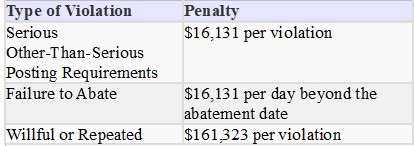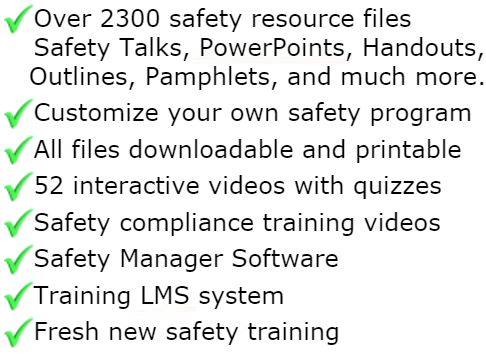
Silica Safety Hazards Information
Dangers of Silica - Silica may be of several distinct types. For example, quartz is a crystalline form of silica and is the most common mineral in the earth's crust. When rock containing quartz is chipped, hammered, drilled, crushed, loaded, hauled, or dumped, small particles of silica are released into the air and can be inhaled by workers.
Member Area Material
Worker Information Cards - PDF Format - Acrobat Reader Required
Health hazard information cards, Crystalline Silica Exposure, will help workers and employers understand more about how they can protect themselves against exposure to silica dust. Two separate cards, available in English and Spanish, provide a quick reference and recommendations for construction and general industry.
Silica Update 2016 - English
Silica Card for Construction - English
Silica Card for Construction - Spanish
Silica Card for General Industry - English
Silica Card for General Industry - Spanish
Technical Information
Silica - Silicosis Technical Sheet
Power Point
Silica Hazards in Industry
Silica Work Practices - procedures followed by both employers and workers to control silica hazards in the workplace. Examples of work practices are
—wet drilling or sawing of silica-containing materials,
—showering and changing into clean clothing before leaving work, and
—avoiding smoking, eating, and drinking in dusty areas.
Silica Respiratory protection - prevents workers from inhaling pollutants. Appropriate respiratory protection equipment and programs should be provided whenever engineering controls and work practices cannot keep concentrations of airborne silica at or below safe limits.
Respirators - Workers can wear special protective equipment called respirators to protect them from inhaling respirable crystalline silica. Respirators are a good option as protective equipment, but they should be used only when controls (such as substitution, automation, enclosed systems, and local exhaust ventilation) cannot keep exposures at or below safe limits.
Workers who perform sandblasting must use the type of respirator recommended by NIOSH for their particular job. Regardless of the abrasive used, NIOSH recommends a respirator that provides a constant supply of clean air through a line that connects to a hood or helmet worn by the worker. The respirator air line must be separate from the line that supplies air for blasting. This device is known as a type CE abrasive-blasting respirator operated in the continuous-flow mode.
Respiratory Protection Program - To make sure that respirators are used properly, the employer must establish a comprehensive respiratory protection program as required in the OSHA respiratory protection standard of 1998 (see the NIOSH Guide to Industrial Respiratory Protection for guidance).
Silica sand containing quartz is used in sandblasting equipment to clean surfaces. The outsides of buildings and bridges and the insides of storage tanks and pipes are some of the surfaces that are cleaned by sandblasting.
The silica sand used in sandblasting breaks into fine particles that stay in the air. If these particles are small enough to be inhaled deeply into the lungs, they are known as respirable crystalline silica. Inhaling these fine silica particles causes more lung damage than inhaling larger particles. This process causes rapid and severe forms of silicosis in sandblasters.
Silicosis - When workers inhale crystalline silica, the lung develops scar tissue around the silica particles. This process results in a lung disease known as silicosis. As more lung tissue is damaged by silica dust, breathing becomes more difficult, chest pain occurs, and death may result. Silicosis patients suffer shortness of breath, fever, and cyanosis. Some patients are diagnosed incorrectly as having pulmonary edema, pneumonia, or other lung diseases.
Preventing Silica Exposure
Industrial hygiene practices are used to protect workers from silicosis and other workplace hazards. These practices include the use of substitution, engineering controls, work practices, respiratory protection, and air monitoring. Employers are responsible for implementing these practices when they are needed to provide safe and healthful workplaces.
Substitution - Several abrasive agents may be used as substitutes for silica sand during sandblasting. Some of the abrasives studied are steel grit, specular hematite, nickel slag, copper slag, crushed glass, garnet, staurolite, olivine, and coal slag. Most of these abrasives work as well as silica sand and cost about the same or even less. However, the use of a substitute may have other adverse effects. Regardless of the type of abrasive, the use of engineering controls, work practices, respiratory protection, and air monitoring to reduce hazards to workers during sandblasting is necessary.
Engineering Controls - Engineering controls are hazard controls designed into equipment and workplaces. Examples of engineering controls are
—automated equipment operated from an enclosed booth,
—enclosed blast-cleaning machines and cabinets,
—tools with dust collection systems, and
—local exhaust ventilation.
Program Material | ||
Fact Sheets | (3) | |
| Crystalline Silica Safety Topic Fact Sheet | Download | |
| Silica Update | Download | |
| Silicosis Safety Topic Fact Sheet | Download | |
Training Material | ||
PowerPoints | (1) | |
| Silica Hazards PowerPoint | Download | |

GET INSTANT ACCESS
to THE MEMBERS LIBRARY
Safety materials created by safety professionals.
Access to the Safety Manager software.
Wide variety of safety videos and courses.
**Brand New** Safety Training Management System
Pre-Made Safety Materials Ready For Use
Created by experienced safety professionals & risk consultants. Saving you time, money, and risk of injuries.
95% of the work already done.
Below are the maximum penalty amounts, with the annual adjustment for inflation, that may be assessed after Jan. 15, 2024. (See OSHA Memo, Jan. 8, 2024).

**New OSHA HEAT 90 DAY**
>>Download Free HERE<<
**New 2024 OSHA 300 Form**
>>Download Free HERE<<
**Brand New**
Free with full membership subscription
Training LMS System
Ask The Safety Consultant
Safety Equipment Deal Finder

“SafetyInfo.com is the first go-to website for safety professionals and companies to use in establishing a solid safety program"
-Mike McKenzie, Certified Safety & Health Manager (CSHM), McSafety Solutions™
Note: You must have a full subscription to the Safety Library in order to use this material. Any use outside of your organization, for resell, or without an active membership is strictly prohibited and may result in prosecution under copyright infringement laws. Please contact us first, if you would be interested in reselling or using our materials for reproduction.
Inside the Members Library
Topic Index
Accident Prevention
Air Quality
Asbestos
Bloodborne Pathogens
Boilers
Chemical Safety
Compressed Gas
Confined Space
Construction
Construction Worksite
Cranes & Slings
Driver / Fleet Safety
Drug Free Workplace
Electrical
Emergency Management
Engineering Safety
Environmental
Equipment
Ergonomics
Fall Protection
Fire Safety & Prevention
First Aid
Flammable Materials
Forklifts
Hazard Communication
Hazardous Materials
Hearing Protection
Heat Stress
Hot Work
Housekeeping
Job Safety Analysis
Laboratory
Ladders
Lead
Lockout-Tagout
Machinery & Equipment
Material Handling
MSDS (SDS)
Medical & First Aid
Occupational Health
Office Safety
Off the Job Safety
Personal Protection
Process Safety
Record Keeping
Respiratory Protection
Silica Safety
Rules & Policies
Signs & Labels
Slips, Trips & Fall
Training
Terrorism Programs
Tool Safety
Vehicle & Driver
Violence Programs
Welding & Hot Work
Training Videos
Library Index
Training Materials
Videos/Courses
Talks
Articles
PowerPoint
Handouts
Training Overheads
Quizzes
Supervisor Briefs
Management Briefs
Safety Sessions
2 Minute OSHA Safety Talks
Pamphlets
First Aid Training
Supervisor Training
Hazardous Materials
Bomb Threat
Crossword Puzzles
Biological Agents
Forms & Documents
Forms
Checklists
Audit Guides
Inspections Guides
Signs & Labels
Environmental Audit Guides
Recordkeeping - OSHA 300
Sign & Label Maker
Safety Management Resources
Safety Manuals/Written Programs
Ergonomic Programs
Emergency Plans
Process Safety Management
Construction Safety
Occupational Health
Environmental
Topic Sheets
DOT Fleet-Driver
Hazardous Materials
Chemical Safety
Drug Free Workplace
Terrorism Programs
Development Guides
Safety Manager Software
Safety References & Graphics
Technical Safety Information
Posters
Topic & Fact Sheets
Development Information
Job Specific Safety Rules
Terrorism
Calculators
Safety Comic Strips
New Safety Training System
Schedule and train your employees with our materials. Add unlimited amount of employees. Record all progress and issue certificates. For group and individual training sessions.

